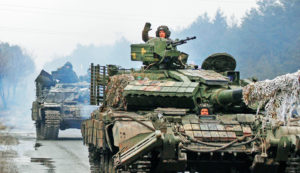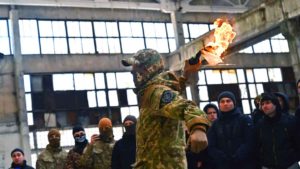Nearly two weeks into the invasion of Ukraine, observing from a distance, it still feels as if there are two different wars, which barely overlap, taking place.
The first is the war on social media: in this war, a combination of genuine and impressive Ukrainian tactical successes and inspiring but self-evidently dubious propaganda stories meld into a narrative of a shambolic Russian army falling apart after failing to seize Kyiv on the first day of war and sinking into a quagmire it cannot win. Boosted by social media influencers, some online veterans of earlier narrative wars, this is clearly the dominant framework, a heroic David and Goliath story emotionally resonant to external well-wishers.
And then there’s the second war, the one on the ground. Every day, new maps are released by professional and amateur military analysts which make grim reading for Ukraine’s supporters. In the south and in the east, a great pincer is slowly grinding forward to surround the bulk of Ukraine’s troops deployed along the line of contact against separatist (that is, pro-Russian Ukrainian) forces. If these Ukrainian troops do not withdraw soon, and form a new defensive line further to the northwest, they will be encircled, starved of supplies and rendered ineffective. In smaller pockets, like the defenders of Mariupol, they will simply be destroyed by artillery.
In the northeast, Russian troops have bypassed the near-besieged city of Kharkiv, nearly encircled the strategic city of Chernihiv, and are moving in force on Kyiv’s eastern suburbs. Around a week ago, the first reconnaissance units were seen outside the satellite town of Brovary. Now they have been reinforced with armoured battalion tactical groups (BTGs) and artillery units, which have begun shelling the area around Kyiv’s Boryspil international airport, presumably to soften it up before continuing to tighten their noose around the city.
Both the optimistic and pessimistic interpretations — viewed from a Ukrainian standpoint — are correct, just as both reveal only partial truths. The brave and dogged Ukrainian resistance has definitely caused the Russians greater losses than they were expecting, at a scale unimaginable to far smaller Western European armies, and has surely slowed their advance. The Russians have pursued often mystifying courses of action, barely using their overwhelming air force, and indeed deploying assets they are known to possess like guided munitions and armed drones at a scale far below that seen in the distinctly less existential Syria conflict.
If the evidence of destroyed and abandoned tanks shown online is any guide, they have preferred to use their older armour rather than their first-line T-90 tanks as the bedrock of their attacking force, perhaps because they are reserving their most modern equipment for a potential military escalation with Nato. On a human level, Russian troops have displayed poor tactical awareness, allowing their convoys to be ambushed by highly-motivated Ukrainian regular and irregular forces, and poor morale, surrendering en masse or simply abandoning their vehicles to capture and destruction and themselves to international derision.
And yet, every evening the map updates are published, and the Russians are still moving forward and pressing dangerously closer to their objectives. It is undeniable that they are taking heavy punishment, and may not be able to sustain this tempo of movement or of losses for many weeks longer; but, then, it seems possible that this phase of the war will be over by then. We should also remember that a Ukrainian-dominated media campaign does not provide a clear sense of the condition of the Ukrainian army after two weeks of war: it too has been taking heavy losses, and its losses are significantly harder to replace. So while it is of course foolish to pronounce with any great certainty about the outcome of a war that is still less than two weeks old, there are perhaps tentative reasons to think that a negotiated settlement may be closer than it looks from outside.
If the interpretation is correct that Putin expected his Russian troops to be welcomed by Ukrainian civilians, or at least tacitly acquiesced to, then he has been dramatically shown otherwise. The scale of Ukrainian resistance has been revelatory, perhaps to Ukrainians as much as to Putin, uniting even previously opposed factions in what is little short of a Ukrainian war of independence. A new legend, one of the type essential in the formation and consolidation of any new nation state, has been born, and has won the Ukrainians the admiration of much of the world. Ukrainian regular troops and newly-enlisted Territorial Defence units have fought doggedly and courageously to blunt the Russian advance. Similarly, Ukrainian civilians (perhaps sensing that the Russian military police occupying them will not clamp down too hard on them at this stage), have begun a growing campaign of public protests against Russian occupation.
Watching all this, Putin must surely sense that even if a narrow military victory is visibly in grasp, the result will only be a political defeat. Ukraine will not happily re-enter the Russian World of his dreams in these circumstances. Even previously sympathetic or ambivalent Russian-speakers in cities like Kharkiv have been lost to Putin by their horrific experience of bombardment.
Instead, the invasion has deepened the common sense of Ukrainian nationhood, as well as deepening its emotional and political enmeshment with the rest of Europe. It is difficult to imagine that, even if they should seize the capital and decapitate the government, the Russians will find occupation an easy or bloodless task. Indeed, the opposite may be true: it is likely the case that the Russians will need to employ the moral and political capital Zelensky has acquired over the course of the conflict in selling a deal to his domestic audience.
If we assume that it is preferable for both sides to avoid the destruction of Kyiv, and the death of thousands on each side during its storming that an assault would entail, then the moment Kyiv is encircled would be a logical moment of pause lending itself to a ceasefire (another such circumstance might be the encircling of tens of thousands of Ukraine’s best troops in the East, but the isolation of Kyiv will likely happen sooner). The Russians and Ukrainians are already negotiating, and Zelensky has at the time of writing begun to hint that the status of the Crimea and Donbas are up for negotiation, and that Nato membership seems unachievable for now: all Russian political goals and not far from the terms Russia initially demanded to stave off an invasion. It would be a difficult domestic sell for Zelensky, after so many tactical victories against overwhelming odds and after forging such a fever pitch of unity against the invader, to sign away what would amount almost to a surrender, but the no-fly zone discourse perhaps points at one way he might.
The Nato summit last week at which the Western alliance emphasised that there would be no no-fly zone created, for risk of escalating into a greater European war, was a very public nudge to the Ukrainians to negotiate in earnest. There simply will be no Nato deus ex machina to dismantle Russia’s superiority in the air or on the ground. Equally, Zelensky’s increasing tendency to lambast the West for not providing enough military support (despite Nato doing everything but engage in open war against Russia on Ukraine’s behalf) can perhaps be setting up the conditions under which he can regretfully sign away control of Crimea and the Donbas and blame it on faithless external patrons. Both regions were probably already gone for good, in any case. It would be a stab-in-the-back myth of sorts, perhaps with unintended consequences down the line, but immediately preferable to a continuance of the war into a second, bloodier phase; these, though, are decisions for Ukrainians to make.
For the Nato alliance, there are two opposing paths to choose between. One strategy would be to force Putin to deal with a long Ukrainian insurgency which would bleed Russia, distracting it to a point where it would pose less of a threat to Nato’s eastern flank. To this end, flooding the country with portable anti-tank weapons and anti-aircraft missiles would, as well as being support for the Ukrainian cause, weaken Russia just as the wars in Iraq and Afghanistan weakened America — most probably more so. Yet against this viewpoint, we can also see that prolonging the war in Ukraine over years or decades would, like the war in Syria, be devastating for the country, for its historic cities and for its people. Two million refugees have already fled for Europe in the war’s first fortnight, and though they are more welcome in Central Europe than Middle Eastern refugees, millions more would be a significant challenge to their hosting nations.
A prolonged insurgency, organised around a rump Ukrainian state in the country’s nationalist western heartland, might not win support for long from neighbouring European states. The prospect of a European Syria or Afghanistan in Galicia and Transcarpathia, where well-armed militia groups who are already a concern would challenge the authority of a weakened, and perhaps exiled Ukrainian administration, from where untraced weapons would likely leak back into the European Union, and along whose borders Nato would daily run the risk of small military incidents with Russia escalating out of control, is not an appealing one to European leaders.
For Ukraine, Russia and the Nato alliance, the next week or so may present a slim opportunity for a ceasefire and de-escalation, introduced by a sudden tilt of the scales in Russia’s favour, such as the encirclement of Kyiv. All sides involved have a clearer appreciation of the facts on the ground than any of us trying to parse the outcome of the war from glimpses of clashes, losses and troop movements on social media’s restricted window. Nato was right to provide Ukraine with the munitions that have made the Russian advance so costly — and which should give Putin pause before ordering the assault on Kyiv. These munitions have enabled the Ukrainians to negotiate from a position of relative strength: yet once Kyiv is besieged, the Ukrainian position will weaken with each passing day.
Nato’s insistence there will be no no-fly zone also puts the already low prospect of a Ukrainian military victory far beyond reach. The alliance has gone almost as far as it can go in supporting Ukraine, and everyone involved knows it. Negotiating a painful peace deal may seem all stick and no carrot for the Ukrainians, who have fought hard and well. The EU should hold firm in insisting on some closer and more generous form of relationship, including membership candidacy status, with postwar Ukraine.
The situation for Russia, though better than it may seem online, is worse for Putin than he would wish. Economically and diplomatically isolated, Russia is now rapidly approaching a narrow military victory on the ground, beyond which a bloody and costly war of occupation appears to stretch into the future. If Putin entered the war with more expansive dreams, he must surely realise they are now beyond his reach.
A golden bridge away from war may now be forming, very soon and for a very short period of time. If those involved do not take it, it is very likely they will all soon wish they had.
Disclaimer
Some of the posts we share are controversial and we do not necessarily agree with them in the whole extend. Sometimes we agree with the content or part of it but we do not agree with the narration or language. Nevertheless we find them somehow interesting, valuable and/or informative or we share them, because we strongly believe in freedom of speech, free press and journalism. We strongly encourage you to have a critical approach to all the content, do your own research and analysis to build your own opinion.
We would be glad to have your feedback.
Source: UnHerd Read the original article here: https://unherd.com





